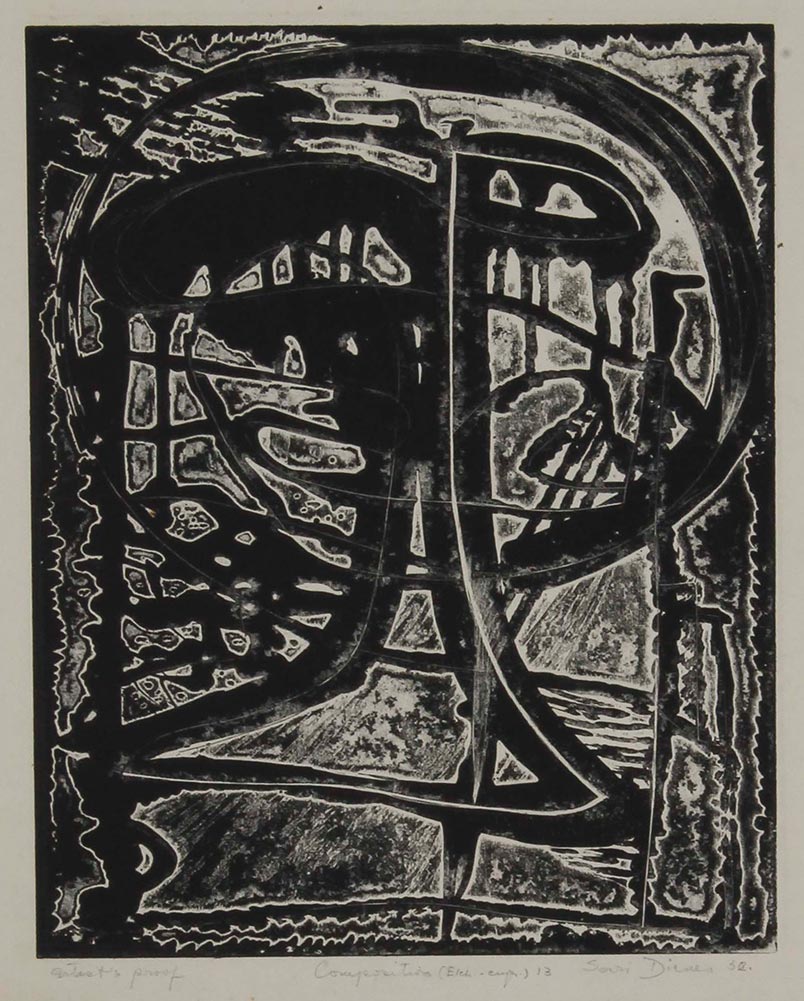23. Sari Dienes
| Life Dates | 1898-1992 |
| Place of Birth | Debreczen, Hungary |
| Place of Death | Stony Point, NY, USA |
| Birth Name | Sarolta Maria Anna Chylinska |
Sarolta Maria Anna Chylinska was born in Debreczen, Hungary.1 In her teens, Sari (pronounced, as the artist explained, “sh” as in sugar, “a” as in art) pursued dance lessons in Budapest with Valéria Dienes, who was married to poet and mathematician Paul Dienes. Sari and Paul became romantically involved and married in 1922. The couple moved frequently for his work, living at times in Austria, Wales, and London. Beginning in the late 1920s through 1935, Sari Dienes—the name she used professionally—studied painting in Paris with Fernand Léger and Amédée Ozenfant at the Académie Moderne and with André Lhote. In 1936 she became the assistant director of the Ozenfant Academy of Fine Arts, London, and was in charge of recruiting new students, who included Leonora Carrington and Stella Snead. In 1939 she voyaged to New York at Ozenfant’s invitation, but the escalation of hostilities in Europe prevented Dienes from returning to England. She instead resettled in New York, and her studio in the Sherwood Studios building on Fifty-Seventh Street was a meeting point for the avant-garde. Her first solo show of drawings occurred in 1942 at the New School for Social Research, and this exhibition may be where she initially encountered Hayter and Atelier 17. She worked at the studio between 1949 and 1952. Always a consummate networker, Dienes befriended many Atelier 17 members and exhibited her prints regularly with the studio (at the Laurel Gallery, Peretz Johnnes Bookshop and Gallery, Milwaukee-Downer College, and Highfield Gallery).2 Her prints are highly finessed, featuring heavily encrusted passages of aquatint and deeply engraved markings produced with the scorper. They are largely abstract with metaphorical references to the primordial unknown and personal transitions. Dienes viewed the production of each print individually and consistently rotated the orientation of impressions pulled from the same plate. The experience of printing these highly textural plates spurred her interest in frottage, a process of rubbing graphite or crayon on paper over an uneven surface.3 Starting in 1952 Dienes began to make rubbings from nature (wood, bark, grass, and flowers), from man-made urban features (manhole covers, subway grates), and from ancient petroglyphs. Besides the inspiration she drew from making prints, Dienes’s experimental work in a neo-dada aesthetic was also fostered through friendships with artists such as Jasper Johns, Robert Rauschenberg, John Cage, and Ray Johnson (Cage and Johnson shared her interest in Zen Buddhism). In 1961 she moved her studio to the utopian cooperative called the Land in Stony Point, New York, and lived there until her death.
Archives
The Sari Dienes Foundation, Pomona, N.Y.
Selected Bibliography
Dienes, Sari, and M. C. Richards. “Sari Dienes: Unconventional Use of Print Techniques.” Craft Horizons 16, no. 2 (March 1956): 36–39.
Hockhausen, Bill. Sari Dienes Retrospective. Sparkill, NY: Thorpe Intermedia Gallery, 1986.
Martin, Henry, and Francesco Conz. Sari Dienes, 1950-1970. Verona, Italy: Galleria La Giarina, 1991.
Metzger, Natalie. “Closer to Life: The Work of Sari Dienes.” M.A. thesis, University of Denver, 2013.
Robinson, Mary B. Modern Masters: Women of the First Generation. New Brunswick, NJ: Rutgers, the State University of New Jersey, 1982.
Sari Dienes. Donna Marxer interviews of artists, 1977-1992, March 4, 1989. Archives of American Art, Smithsonian Institution.
“Sari Dienes.” Art News 41 (January 1, 1943): 30.
“Sari Dienes.” Art News 47 (April 1948): 63.
Zeller, Kate. “Making Her Mark: Sari Dienes and Her Street Rubbings in 1950s New York.” M.A. thesis, School of the Art Institute of Chicago, 2008.
Notes
- The Sari Dienes Foundation, Pomona, N.Y., is an excellent source of information about the artist’s career and work. Thank you to Barbara Pollitt and Rip Hayman for sharing memories of Dienes. ↩
- Dienes’s 1952 application to the artists’ colony Yaddo provides a fairly complete record of her education, exhibition, and other professional activity. Courtesy of the Sari Dienes Foundation, Pomona, N.Y. ↩
- In discussing her frottage work, Dienes said, “My work in graphics was of great help to me.” Sari Dienes and M. C. Richards, “Sari Dienes: Unconventional Use of Print Techniques,” Craft Horizons 16, no. 2 (March 1956): 36. ↩

